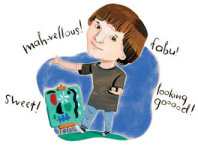
« PREVIOUS ENTRY
Deadline Jan. 31 for entries to Best of Technology Writing 2008

Very small children are brutally honest. Show them a picture you’ve painted, sing them a song you wrote: If they don’t like it, they have no problem telling you that you suck.
So when precisely does the ability to disguise one’s opinion emerge — to engage in what psychologists call “ingratiation behaviort”, and lie and say that you’re impressed when you’re not? I was surprised to learn that researchers haven’t looked too closely at the beginnings of flattery. Apparently the first studies have recently been done by KangLee at the Ontario Institute for Studies in Education. As the University of Toronto Magazine reports:
They asked a group of preschool children ages 3 to 6 to rate drawings by children and adults they knew, as well as strangers. The preschoolers judged the artwork both when the artist was present, and when he or she was absent. The three-year-olds were completely honest, and remained consistent in their ratings; it didn’t matter who drew it, or whether the person was in the room. Five- and six-year-olds gave more flattering ratings when the artist was in front of them. They flattered both strangers and those they knew (although familiar people got a higher dose of praise). Among the four-year-olds, half the group displayed flattery while the other half did not. This supports the idea that age four is a key transitional period in children’s social understanding of the world.
There are, Lee says, two reasons to flatter: Either to reward someone’s behavior, or to butter them up in case you need them to be nice to you later on. Lee’s not sure which strategy the four-year-olds are pursuing. But because they flattered strangers as well as people they knew suggests “they are thinking ahead, they are making these little social investments for future benefits.”
I'm Clive Thompson, the author of Smarter Than You Think: How Technology is Changing Our Minds for the Better (Penguin Press). You can order the book now at Amazon, Barnes and Noble, Powells, Indiebound, or through your local bookstore! I'm also a contributing writer for the New York Times Magazine and a columnist for Wired magazine. Email is here or ping me via the antiquated form of AOL IM (pomeranian99).

ECHO
Erik Weissengruber
Vespaboy
Terri Senft
Tom Igoe
El Rey Del Art
Morgan Noel
Maura Johnston
Cori Eckert
Heather Gold
Andrew Hearst
Chris Allbritton
Bret Dawson
Michele Tepper
Sharyn November
Gail Jaitin
Barnaby Marshall
Frankly, I'd Rather Not
The Shifted Librarian
Ryan Bigge
Nick Denton
Howard Sherman's Nuggets
Serial Deviant
Ellen McDermott
Jeff Liu
Marc Kelsey
Chris Shieh
Iron Monkey
Diversions
Rob Toole
Donut Rock City
Ross Judson
Idle Words
J-Walk Blog
The Antic Muse
Tribblescape
Little Things
Jeff Heer
Abstract Dynamics
Snark Market
Plastic Bag
Sensory Impact
Incoming Signals
MemeFirst
MemoryCard
Majikthise
Ludonauts
Boing Boing
Slashdot
Atrios
Smart Mobs
Plastic
Ludology.org
The Feature
Gizmodo
game girl
Mindjack
Techdirt Wireless News
Corante Gaming blog
Corante Social Software blog
ECHO
SciTech Daily
Arts and Letters Daily
Textually.org
BlogPulse
Robots.net
Alan Reiter's Wireless Data Weblog
Brad DeLong
Viral Marketing Blog
Gameblogs
Slashdot Games